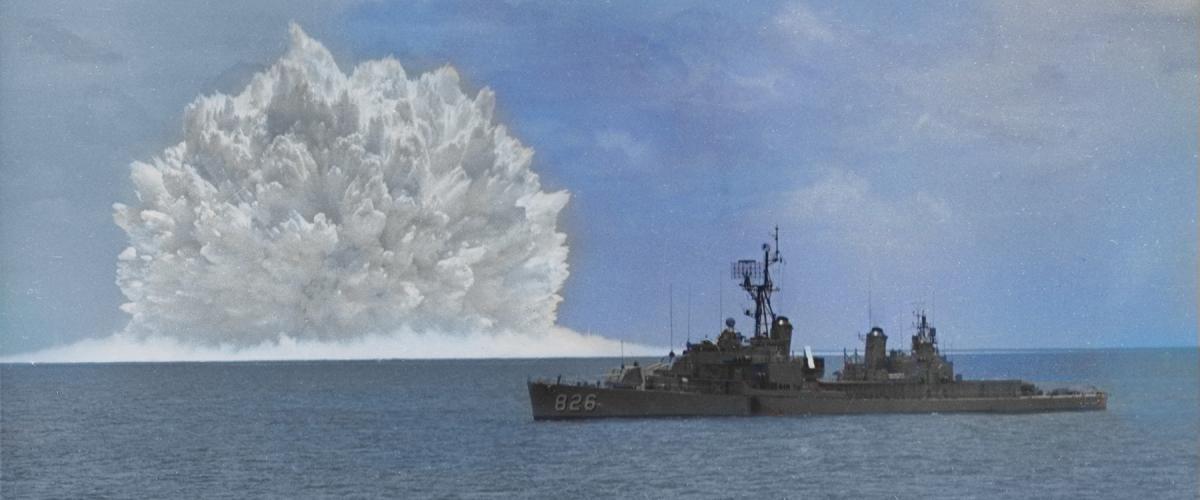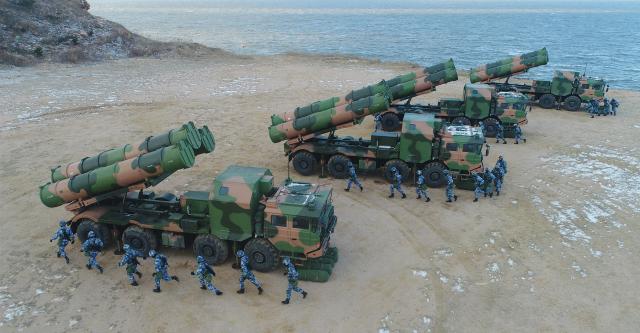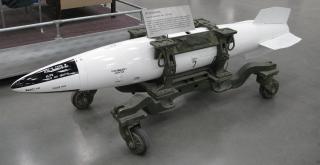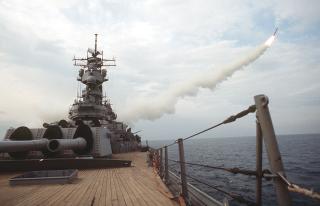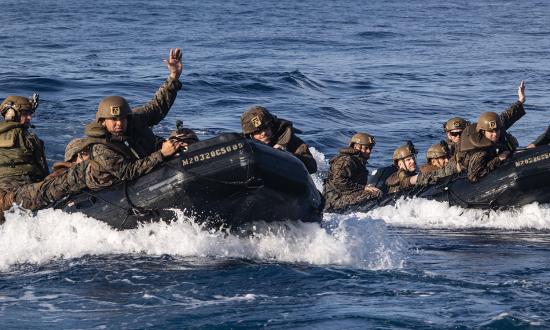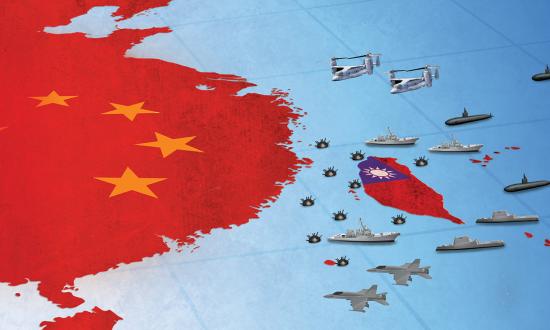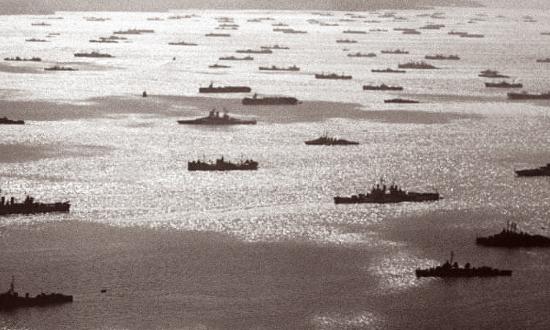In his most recent invasion of Ukraine, Vladimir Putin has reminded the world of the potential use of tactical nuclear weapons and the attendant implications for escalation to strategic nuclear weapon exchanges.1 Russian nuclear threats run parallel to the inexorable development of nuclear weapons by smaller states and a huge push by China to increase its nuclear arsenal. These changes highlight new-old realities of nuclear strategy, policy, and operations.
To deal with these realities, the United States must put aside the counterproliferation playbook and change the subject from arms control to firepower. This is both a DoD issue and, more specifically, a Navy issue, in which the sea-launched nuclear-armed cruise missile (SLCM-N) should play an initial prominent role. The Navy’s dispersion at sea provides the best advantage in every theater, with submarines, surface warships, and aviation squadrons able to close what retired Navy Admiral Charles Richard, while commander of U.S. Strategic Command, called a serious “deterrence-assurance-escalation” gap caused by the tactical hole in U.S. nuclear capabilities and posture.2
The last time these issues were on the table, George H. W. Bush was President, and the trend was in the other direction, toward nuclear disarmament, stockpile reductions, and broad-based nonproliferation policies. In the afterglow of the Cold War, in what was then applauded as a reasonable and prudent initiative, President Bush announced the unilateral demobilization of the Navy’s tactical nuclear weapons and the withdrawal of U.S. nuclear weapons from the Republic of Korea.3
A centerpiece of the early post–Cold War rush to reduce nuclear arsenals, the 1994 Budapest Memorandum provided ostensible security guarantees to Belarus, Kazakhstan, and Ukraine in exchange for surrendering their ex-Soviet nuclear weapons.4 This agreement prohibited the Russian Federation, the United Kingdom, and the United States from threatening or using military force or economic coercion against these states. It was a different time. Russia and China were weak. With Cold War antagonisms and arsenals reduced, emphasis turned to nonproliferation, in which U.S. influence was greatest, in its own arsenals and in allied capitals.
Unfortunately, Putin’s 2022 invasion of Ukraine and nuclear saber rattling is reminscent of Cold War challenges. In the meantime, China’s nuclear arsenal has grown rapidly. In 2021, former senior Pentagon official Dr. Mark Schneider wrote, “The 2020 Pentagon report . . . dramatically underestimates the number of Chinese non-strategic nuclear weapons. Credible sources, including Russian experts, believe the number is much higher, mainly reflecting their belief that China has a very large arsenal of tactical non-strategic nuclear weapons.”5 Just two years later, the Pentagon’s 2022 report to Congress on Chinese military power stated, “In 2021, Beijing probably accelerated its nuclear expansion. . . . The PRC’s operational nuclear warhead stockpile has surpassed 400.” The report goes on to say, “If China continues the pace of nuclear expansion, it will likely field a stockpile of about 1,500 warheads by 2035.”6
The 2022 report also states:
• China probably seeks lower-yield nuclear warhead capabilities to provide proportional response options that its high-yield warheads cannot deliver. PRC strategists have highlighted the need for lower-yield nuclear weapons to increase the deterrence value of China’s nuclear force, though they have not defined specific nuclear yield values.
• The DF-26 is China’s first nuclear-capable weapon system that can conduct precision strikes, and therefore, is the most likely weapon system to field a lower-yield warhead in the near-term.
• Chinese military writings in 2021 noted that the introduction of new, precise, small-yield nuclear weapons could possibly allow for the controlled use of nuclear weapons, in the warzone, for warning and deterrence. . . . while strategic nuclear weapons remain the foundation of deterrence, tactical nuclear weapons with high hit precision and smaller yield would be effective in lowering the cost of war. Such discussions provide the doctrinal basis for limited nuclear employment . . . suggesting PRC nuclear thinkers could be reconsidering their long-standing view that nuclear war is uncontrollable.7
Clearly, China is thinking about nuclear war—including at the tactical level.
What to Do?
These developments should give Pentagon leaders pause. In traditional Cold War calculations, the United States would be rebuilding nuclear arsenals and refitting Navy ships and aircraft for those weapons. Tactical nuclear weapons were a key part of Cold War deterrence, war planning, and escalation control. Absent any evolution of thinking, they remain so. Nevertheless, the few remaining U.S.-NATO tactical nuclear weapons notwithstanding, DoD and the Navy have been out of the tactical nuclear weapons business for a long time. Despite the changes in China, Russia, and elsewhere, the recent DoD Nuclear Posture Review declared the SLCM-N “no longer necessary,” contradicting the Navy and Joint Staff.8
For the Navy, these developments should stimulate thinking about what to do regarding naval tactical nuclear weapons. In the context of this second phase of the American Sea Power Project—the “ways” of naval power and how to use it—what should be the Navy’s tactical nuclear weapons capability and force posture? Is it a good idea to reintroduce tactical nuclear weapons into the fleet, perhaps starting with, but not necessarily limited to, SLCM-Ns?
During the Cold War, U.S. Navy air-, surface-, and sub-launched tactical nuclear weapons had a sobering effect on Soviet thinking, and they helped create a turning point strategically and in the balance of power. When Soviet Marshall Sergei Akhromeyev visited Chairman of the Joint Chiefs Admiral William Crowe in the Pentagon in December 1987, he presented Crowe a map depicting the pressure the U.S. military had applied to the Soviet Union late in the Cold War. Tomahawk SLCM range arcs were prominently displayed.9
By deploying tactical nuclear weapons throughout the fleet, the Navy was transformed into an overwhelming peripheral threat from the sea against Soviet targets ashore. The surface force, tactical aviation, and attack submarines became a potent tactical nuclear attack force operating on numerous axes.
Navy surface combatants became part of the operational and deterrent solution, not part of the force to be protected by fleet air wings and submarines. The outcome was a drastic nuclear warfighting complication for Soviet defenses against Navy cruise missiles and aircraft. The effect on deterrence and escalation control of the Navy’s ability to project tactical nuclear firepower ashore was remarkable.
Likewise, tactical nuclear war at sea became much more evenhanded. Striking power against the Soviet surface fleet was greatly increased, and the development of nuclear antisubmarine weapons (antisubmarine rockets and depth charges) virtually ensured a platform kill against increasingly advanced Soviet submarines. This integration of tactical nuclear weapons presented an intractable problem for the Soviets.
From today’s perspective, this nuclear escalation and proliferation throughout the Navy seemed to take a natural course that is no longer available. The Cold War nuclear context was a fact of life—accepted, albeit dangerous and uncomfortable. The Navy lived with nuclear weapons everywhere—at sea and at home—and incorporated them throughout its force structure and into its operational doctrine, posture, and culture. Intrinsic antinuclear sentiment was checked by the realities of the day.
Today’s context, and the potential course for the Navy, might seem quite different. This is not simply a firepower issue. The prospect of Chinese and Russian tactical weapons at sea dredges up difficult issues regarding basic national strategy and nuclear escalation.10 But what has emerged is a new nuclear context, different from the Cold War in degree but not so different in kind. Today’s multipolar world is one of nuclear proliferation—despite 30 years of Washington’s best efforts to slow or reverse the spread. These new realities point to a need for U.S. tactical nuclear firepower commensurate with the threat, and with foundational security guarantees to allies.
Historical Precedent: Unrestricted Submarine Warfare
Today’s nuclear circumstances present more questions than answers, but they suggest an important early conceptual juncture that has the potential for substantial change. A useful historical precedent is the Navy’s thinking about a new doctrine for unrestricted submarine warfare in the 1930s followed by its quick adoption at the start of World War II.
With the outbreak of war in Europe, Germany reintroduced unrestricted submarine warfare in its second bid to control the oceanic flow of commerce, materiel, and military forces. Fortunately, U.S. Navy leaders had been considering this strategic problem and how to use the fleet to solve it for some time. In 1938, in front of the Senate Naval Affairs Committee, then-Chief of Naval Operations Admiral William D. Leahy was asked what he wanted out of any naval buildup. Leahy was unequivocal that controlling movement was essential, and that the United States needed to be able to impose a blockade and at the same time not allow another power to control the movement of American goods and supplies.11
Two key issues were involved. The first was what was going to be the nature of this brewing great power conflict. The eventual answer, expressed by Admiral Leahy, was naval blockade, resulting in the Navy adopting unrestricted submarine warfare to dramatic ends. This came at a time when, in the aftermath of World War I’s First Battle of the Atlantic, unrestricted submarine warfare was anathema—and literally against the law. But it was not illegal to think about unrestricted submarine warfare, and the Navy proceeded to do so, quietly and to good effect, as documented by Joel Holwitt in Execute Against Japan—The U.S. Decision to Conduct Unrestricted Submarine Warfare.12
The second key issue was framed by this prewar cognitive, doctrinal, and analytical effort between the Chief of Naval Operations, the Naval War College, and the fleet: how to get ahead of the pending exigencies of great power war, think about those new circumstances in advance, and develop the thinking and responses that would enable the rapid doctrinal shift the Navy saw coming.
Next Steps
Similarly, the Navy today must get ahead of current tactical nuclear weapon policies, and in so doing shape broader political, policy, and legal frameworks. The work product will have to include necessary rationale and the technical and operational changes to put these weapons back in the fleet.
Navy considerations of tactical nuclear weapons will have to be part of a national nuclear strategy that takes into account new circumstances.
The first is China’s rapidly growing nuclear arsenal. Admiral Richard’s observations regarding deterrence and escalation gaps address the growing operational and strategic dichotomy between China and the United States and provide the germ of the practical reasoning for bringing tactical nuclear weapons back.
Second, an entire generation of naval personnel have entered the service, served, and retired since the last U.S. Navy tactical nuclear weapon went to sea. This means thinking about these issues cannot depend on a store of internalized, shared experience, developed doctrine, and strategic and operational best practices. The historical record is not everything, but getting ahead of new-old realities will require careful review of what came before. This is especially germane since there exist fairly analogous strategic, doctrinal, political, operational, and technical precedents to be considered.
Third is that raising the topic of tactical nuclear weapons essentially changes the subject from proliferation to firepower, a conceptual break with numerous consequences. If tactical nuclear weapons are a key part of deterrence, escalation control, and warfighting structures going forward, then otherwise understandable preferences for arms control will have to give way to this deterrence and firepower logic.
Fourth, tactical nuclear considerations should not be seen just in the context of China’s first-among-equals challenge. It is essential to think about tactical nuclear weapons and their role in deterrence and escalation control from a wider, global perspective.13 In a world in which Russia and China already present the specter of a Eurasia-wide nuclear challenge, and in which North Korea is both a wild card and a nuclear surrogate, the lack of tactical nuclear weapons would make the United States vulnerable and inflexible in having to rely only on strategic nuclear weapons. This is the deterrence and escalation gap Admiral Richard has identified and that U.S. allies clearly perceive.
SLCM-N
For the Navy, SLCM-N is going to be the most immediate and relevant program moving forward, potentially with outsize effect on U.S. policy. A decision to field SLCM-N—not just in submarines, but also in the Navy’s surface fleet—would clear the way for the broader issues of the role of tactical nuclear weapons in deterrence, escalation control, and overall strategy.14
With national policy weighing on the program, the Navy is in circumstances similar to those Admiral Leahy faced in the late 1930s with regard to unrestricted submarine warfare. Then, it was Navy answers and solutions that shaped and filled the gaps in national strategies. Then, it was against-the-grain unrestricted air and submarine warfare that enabled the strategic realization of Leahy’s operational prescription for blockade and controlling movement.
Today’s parallel is tactical nuclear weapons at sea and ashore. There is a large, growing deterrence and escalation gap and increasingly unacceptable realities. Taking a page from history means getting ahead of the issue now; expressing in defense and national councils the strategic and operational need and rationale for SLCM-N as a first example; and calculating and planning for force structure, technical, training, and infrastructure requirements. If the Navy does not follow through, it will miss a critical once-in-a-generation opportunity to level the field with China, respond to Russia’s aggression, and manage North Korean threats.
Allies Question Credibility Of U.S. Umbrella
The dichotomy between U.S. tactical nuclear weapon capabilities and those of China, Russia, and North Korea is clear to observers in other countries. Allies, most notably Japan and South Korea, are questioning the United States’ credibility and its ability to respond in a tactical nuclear context.1 Unofficially (albeit with great consequence), some authoritative and experienced Japanese statesmen are concluding that no U.S. president would defend Japan against nuclear weapons, and that the U.S. Navy could not get forward or stay forward in a conflict with China over Taiwan.2 The Republic of Korea has raised reintroducing U.S. tactical nuclear weapons ashore and afloat to deter North Korea, and the recent Washington Declaration by U.S. President Joe Biden and South Korean President Yoon Suk-yeol may not be enough for South Koreans who feel Seoul needs its own nuclear arsenal.3 Without a strong and discernable response plan shared with and publicly visible to allies and adversaries alike, U.S. gestures of reassurance appear unconvincing and may actually encourage domestic nuclear weapon programs in Japan, South Korea, and elsewhere.
Tokyo and Seoul, discomfited by what they see as pending failures of nuclear umbrella security guarantees, are calling for changes in their own and U.S. nuclear postures. During the Cold War and until now, such statements from these allies would have been extraordinary, but circumstances have changed. The issue has expanded beyond U.S. arsenals to how best to combine traditionally unilateral U.S. nuclear weapon efforts with heretofore nonnuclear allies in the face of Russian and Chinese escalation.
It is never a bad thing for the U.S. national security establishment to see itself and the issues it struggles with from outside perspectives. Allies that depend on U.S. extended deterrence guarantees have expressed concerns regarding China’s buildup of naval tactical nuclear weapons.4 They have made clear their preference for being under the U.S. nuclear umbrella and for the United States to reintroduce naval tactical nuclear weapons—and with a more explicit posture than during the Cold War.5
The longstanding logic of U.S. allies in northeast Asia is straightforward. According to Alex Wellerstein, an expert on the history of nuclear weapons, “G7 countries, rightly or wrongly, generally think that their sovereignty and security is underwritten by nuclear weapons—either theirs or their allies’. To put it bluntly, they think that without them, there would be far more danger to them from Russia or Chinese military activity.”6
Existing extended deterrence frameworks are now seen as rhetorical and political, not practical. This is why both Seoul and Tokyo are looking for reassurance, rearmament, and redeployment from the United States.
In February 2023, a Japanese defense study group chaired by Ryoichi Oriki, a former Japan Self-Defense Forces chief of staff, suggested Japan ease its three nonnuclear principles that prohibit possessing, producing, or allowing entry into Japan of nuclear weapons. The relaxation would allow nuclear-armed U.S. warships and military aircraft to enter Japanese waters and airspace for port calls and deployments as the situation demanded. Oriki’s suggestion made it clear that options are being considered that are not shackled to old defense doctrines.7 Tokyo and Seoul would have to take many steps before either would initiate its own nuclear weapons program, but part of their decision process will be Washington’s reconsideration of tactical nuclear weapons at sea.
This is the “glass-half-full” aspect of allied thinking about U.S. tactical nuclear weapons, in which allies commit to policies in the context, and ostensibly follow the lead, of the United States. U.S. nuclear guarantees are the foundation of the alliances with Japan and South Korea, with North Korea’s unremitting nuclear buildup and China’s own actions putting a fine point on these dependencies.
By contrast, the emerging “glass-half-empty” reality is that absent apparent and useful U.S. tactical nuclear weapon capabilities, Japan and South Korea are exploring distinctly different political and security options, without reference to or alignment with the nuclear policies and capabilities of the United States. Allies always have alternatives, and their strategic positions can change over time, especially when the credibility of underlying assumptions is seen to be diminishing. As an example, Japan has—and South Korea had and can have again—its own undeclared nuclear weapon program.8
The upshot of these alternatives is a future in which either Northeast Asia’s security will be guaranteed by the United States, or numerous regional nuclear arsenals must cohabitate uneasily.
1. Yoshiko Sakurai, “Japan Is in Dire Need of a Nuclear Strategy”, Japan Forward, 7 May 2023.
2. Yuki Tatsumi, “Voices from Japan: Japan’s National Security Strategy in the Era of Strategic Competition—Interview with Nobukatsu Kanehara,” The Stimson Center, 5 December 2022. In this interview, Japan’s former assistant chief cabinet secretary repeated numerous times that the U.S. nuclear umbrella was “in tatters” or “gone” and that this was common discussion on evening talk shows in Japan. He contended that, in the face of Chinese aggression, the United States would not push the U.S. Navy forward and the U.S. Navy could not get forward or stay forward; the United States would never respond to a tactical nuclear weapon; and Japan must consider different and more self-reliant nuclear security actions.
3. Hyonhee Shin, “Seoul Mayor Calls for South Korean Nuclear Weapons to Counter Threat from North,” Reuters, 12 March 2023.
4. Hiroyuki Akita, “Why Nuclear Arms Debate in South Korea Cannot Be Underestimated,” Nikkei Asia, 5 May 2023.
5. Gabriel Dominguez, “U.S. Pledges Stronger Nuclear Deterrence, But Is South Korea Buying It?” Japan Times, 27 April 2023.
6. Gabriel Dominguez, “G7 Adopts Kishida’s Vision for a Nuke-free world, But Disarmament Likely Elusive,” Japan Times, 20 May 2023.
7. Akita, “Nuclear Arms Debate in South Korea.”
8. During a conversation with the author in Tokyo several years ago, an old Japanese friend and very senior ambassador abruptly said, “You know, these rumors of Japan having a nuclear weapon in a month are ridiculous. It would take at least six weeks.” My impression at the time and since was that he was being perfectly—and purposefully—serious. For the proliferation dispute between the United States and the Republic of Korea, see Jeffrey W. Taliaferro, Defending Frenemies: Alliances, Politics, and Nuclear Nonproliferation in U.S. Foreign Policy (Oxford, UK: Oxford University Press, 2019).
1. Lauren Sukin, “Rattling the Nuclear Saber: What Russia’s Nuclear Threats Really Mean,” Carnegie Endowment for International Peace, 4 May 2023.
2. Joe Gould, “U.S. Strategic Command Chief: Sea Missile Cancellation Opens ‘Deterrence and Assurance Gap,’” Defense News, 5 April 2022.
3. Kyle Mizokami, “Tactical Nuclear Weapons at Sea,” U.S. Naval Institute Proceedings 146, no. 8 (August 2020).
4. Mariana Budjeryn and Matthew Bunn, “Budapest Memorandum at 25: Between Past and Future,” Managing the Atom Project, Belfer Center, Harvard University, March 2020; and Daryl G. Kimball, “Ukraine, Nuclear Weapons, and Security Assurances at a Glance,” Arms Control Association, February 2022.
5. Mark Schneider, “The Number of Chinese Nuclear Warheads,” Real Clear Defense, 27 April 2021.
6. Department of Defense, Office of the Secretary of Defense, “Military and Security Developments Involving the People’s Republic of China 2022,” ix.
7. Department of Defense, “Military and Security Developments,” 98–99.
8. Secretary of Defense Lloyd Austin, 2022 National Defense Strategy of the United States of America – Including the 2022 Nuclear Posture Review and the 2022 Missile Defense Review (Washington, DC: Department of Defense, 27 October 2022), 20.
9. For a description and the implications of Marshall Akhromeyev’s Map, see John Lehman, Oceans Ventured – Winning the Cold War at Sea, ch. 7, “The Soviets (and Others) Get the Message, 1986-1988: The Cold War Hurtles Toward its End” (New York: W.W. Norton, 2018).
10. Austin, 2022 National Defense Strategy; and Gould, “U.S. Strategic Command Chief.”
11. See “Leahy Insists on Navy Able to Crush Any Foe,” Washington Post, 6 April 1938, quoted in Phillips Payson O’Brien, The Second Most Powerful Man in the World – The Life of Admiral William D. Leahy, Roosevelt’s Chief of Staff (New York: Dutton, 2019), 118.
12. Joel Ira Holwitt, Execute Against Japan–The U.S. Decision to Conduct Unrestricted Submarine Warfare (College Station, TX: Texas A&M Press, 2009), 61-62, 75-83.
13. This broader perspective includes the Eurasian entity; how that entity has played in U.S. geostrategy from the beginning of the republic; and, more recently, how U.S. nuclear security guarantees have underscored the U.S. commitment to the global order, rule of law, and United Nations Charter. See Seth Cropsey, “America and the Idea of Eurasia,” Real Clear Defense, May 23, 2023.
14. Some commentators object to SLCM-N because ostensibly it would take space in Navy submarines needed for other weapons and missions. That is an accurate assessment, although it does not consider the value of SLCM-Ns. However, it is insufficient to construe SLCM-N only in a submarine context.



